Sensor Sensibility: New Information from Toumaz CEO
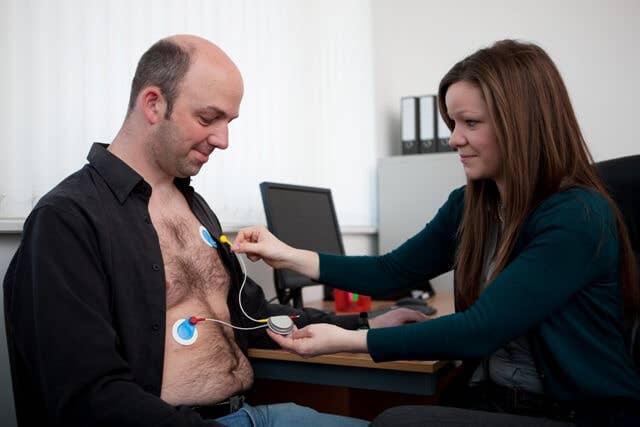
Share
It's time to let your left hand know what your right hand is doing. For anyone who has visited the hospital recently, medical sensors should be familiar to you. Little sticky pads for ECG and EEG, thermometers, biochemical monitors...there a thousand things doctors can stick on or in you. Up to now, the data from each sensor was collected separately, transmitted separately, and often analyzed separately. The correlation between activities in your heart, head, and hands was largely absent. Until now.
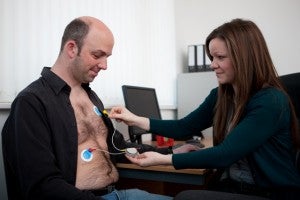
Britain's Toumaz Technology has developed Sensium, a device that allows data collected from various sensors on your body to be collected, processed, and transmitted via wireless signals in a single network. They don't make the sensors, but they allow you to synchronize the signal from each one. That's a key ingredient in getting better care. It also has huge applications in sports and fitness. A small Belgian company working with an Italian football club (read here: soccer) has been using earlier generation bulky devices to record the timing of their players movement, stress levels, and other factors. With their own algorithms they are able to predict the mental state of their players. They are now looking to use Sensium to bring a non-intrusive, real-time element to this technique. Knowing the precise time and way to field players could be a winning edge.
Singularity Hub was impressed with Toumaz Technology before, so much so that we hunted down its CEO, Keith Errey, for an exclusive phone interview. From that conversation we were able to get some great insights into how the company will change the way that we monitor our health. Hear about the exciting new information after the break.
"There is a whole new set of things that are gonna be understood and [help us] learn about how we actually are and operate and respond as physical beings." -- Keith Errey June 30, 2009
I am stuck on Sensium because Sensium's stuck on me
Toumaz Technology started off with a key concept: the signals from the body create a 'human space' and if you want to operate in the human space you have to be unobtrusive, robust, and continuous. Sensors are already being crammed all over your body, so the device that interacts with them needs to add as little to that problem as possible. That's why Sensium is an ultra-low power device. Each chip works on one tenth to one twentieth the power of a standard Bluetooth headset. Yet, even at low powers the devices can send a stream of data at 50kbps. And that's continuous, not burst, transmission, meaning that each sensor is correlated with others down to the millisecond level. This information is sent from the device to a base receiver. That receiver can then communicate with other stations to share data on a larger network (a hospital, for instance).
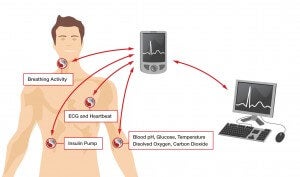
But wait, ultra-low power also means ultra-low mass, and a tiny device can do things others can't. As part of its ongoing research and development, Toumaz is beginning testing of a 'smart patch' version. This patch would be a disposable band-aid style device that could be applied to a patient. For four or five days (the average hospital stay in the Western world and the lifespan of the Sensium chip battery) all sensor data could be collected and routed to doctors in real time. Imagine, having a doctor open her PDA and have access to each of her patients vital signs. Or, that same PDA could have a program that alerts her to changes in a condition. No more paging doctors when something goes wrong. The doctor could see when things were about to go wrong and get there before they do.
The band-aid version of Sensium isn't some pie in the sky dream. It's happening soon. The day before our interview with Keith Errey, the prototypes were off to the converters to begin a large production. In August, clinical trials will begin at hospitals associated with Imperial College, London. Remember that ultra-low power also means ultra-low costs. According to Mr. Errey, the smart patches could cost "two digits, maybe less" to manufacture. While hospitals may be willing to pay quite a bit more, the low production costs mean that this device could have a nearly universal presence in Western hospitals within the next five years.
Part of a Whole
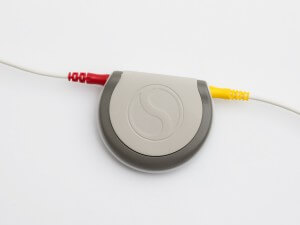
While the smart patch is coming soon, the Sensium Life Pebble is already here. This non-disposable version of the sensor networking hub is housed in a more robust shell and can have batteries replaced. It also has three-dimensional accelerometers to track motion. According to Errey, this device won't cost considerably more than the smart patch because it's "basically the same functionality." The Life Pebble is days away from CE marketing approval, meaning that Toumaz can start selling it all over the European Union, either to health professionals or just your average citizen. Unlike hospitals, which already have systems in place to transmit vital signs, your home is an untapped mine of health information. Life Pebble will help you access that data.
Be Part of the Future
Sign up to receive top stories about groundbreaking technologies and visionary thinkers from SingularityHub.


As impressive as the various Sensium devices are, however, they are just part of the entire Sensium system. What has impressed me with Toumaz is the forward-thinking problem solving inherent in their design. Sensium is as much a software and networking protocol as it is a silicon chip. Toumaz has devised ways of working around signal blocking, switching channels, and the myriad of other forms of interference that could impede the ultra-low wireless communication. That's a good thing if you don't want a heart-attack to go unnoticed.
The actual network has limitations. The range for wireless communications is about five to ten meters from the Sensium chip to the receiver, the same for Bluetooth more or less. From that receiver, the signal can be sent longer distances to a relay station, computer, or other network hub. According to Errey the network will utilize a star networking scheme with 8 chips to a single receiver. Each chip could handle about 6 different kinds of sensors. While this is actually impressive for today's technology, I wonder how this will hold up in an emerging hospital environment that will have more technology and more patients per square foot than current ones. Undoubtedly the network will have to advance with demands.
Your Body in the Future
While the model environment for health monitoring may seem to be a hospital, that will likely change very soon. As Singularity Hub has stated before, the future holds promise of almost continuous monitoring, whether you are in good health or poor. When asked if Toumaz Technology is prepared for this trend, Errey says "Absolutely...The requirement to understand your own physical state--the well being or sickness, however you want to define it-- is pretty universal." In Toumaz's opinion, even if you aren't an Italian soccer star, you're going to want to know how your body is doing.
Which is part of the reason why Toumaz has given Texas Instruments (TI) a distributing license for the Sensium hardware. Part of that partnership will see Toumaz and TI develop an open source, or open API type protocol to allow users to design their own method of using the monitoring device. We could see third party applications that allow us to design how we use common sensors in our homes or at work. Wouldn't it be nice to know if your reflexes were too impaired to drive, or if your child actually was too sick to go to school?
The continuous monitoring of our actions could lead to some very interesting insights into how our bodies work. Like those Italian footballers, we could learn a lot about how we work, and use that to develop all kinds of new health plans or technologies. Errey pointed out that, "The reason this generally hasn't been recognized to date is that it's been too expensive to have this kind of knowledge, and it was always taken in the context of a pathological state. You were always strapped up and monitored in a hospital...What it's like to be healthy and active, that's working with new data."

This new data could be collected by individuals on themselves, but it could also be sent to doctors, employers, children, spouses, or the government. So we have to ask ourselves, who owns the data about your health? "That's the 64 million dollar question," says Errey. "At the technology layer itself I don't think there's an issue...There's an inherent privacy in the system." The Sensium network is hard to eavesdrop on, and there are software encryptions available. Built-in encryption will be a staple in the next generation of the devices.
However, the data has to be stored somewhere. Patients or doctors, or whoever will want access to it. "At that point, these questions become very very pertinent...very serious. Who do you trust with the data? Who owns the data? It's going to be a very interesting debate." Just to highlight the scope of that debate, Toumaz Technology LTD is developing partnerships not only with TI but also with companies in the veterinary, military, and law enforcement sectors.
It's too early to tell if Toumaz will be THE monitoring network technology of the future. Even Errey admits that there is more than one way to approach the challenge. Sensium, however, is the only ultra-low power device of its kind, and would seem to be the least obtrusive. No matter which technology is eventually used however, the trend is clear: we're going to be watching our bodies a whole lot closer. As that data is collected we'll all have to worry about not only what the data means, but who gets to look at it. Just as we hope to learn more about ourselves, we may want to keep more hidden from others. If not for our own pride, then to avoid the prejudice that could come with the information.
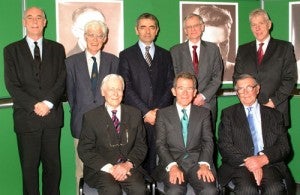
Related Articles

Hugging Face Says AI Models With Reasoning Use 30x More Energy on Average

How Scientists Are Growing Computers From Human Brain Cells—and Why They Want to Keep Doing It

Study: AI Chatbots Choose Friends Just Like Humans Do
What we’re reading